 The Holy Office in an old print
The Holy Office in an old print
Padre Pio 35-72 (’22-’59)
Restrictions, investigations, isolation, reinstatement, restrictions, reversal.
 The Holy Office in an old print
The Holy Office in an old print
During this same time the Holy Office continues to receive slanderous
accusations from Mons. Gagliardi, which will turn out to be groundless.[1]
On June 2, 1922 the Cardinals of the Holy Office wrote to the minister general
of the Capuchin order, ordering: to “avoid any oddity and commotion”; Padre Pio
is “prohibited to impart benedictions on the people”; prohibited to “show the
so-called stigmata”; stop “any communication, even by way of letter” with Padre
Benedetto; “prepare to transfer Padre Pio” whenever the popular mood will make
it possible; Padre Benedetto has “to turn over the Chronicle
(“Cronistoria”) of the friary written
by him and has to stop to talk and write about Padre Pio.”[2]
On July 22, 1922, the superior general of the capuchin order sent his own
visitor: Padre Celestino da Desio stayed six days in the friary. He questioned,
listened, observed, not only the friars, but also the people and the civilian
authority. He reported that he was firmly convinced that the denunciations were
calumny intended to force the faithful to return to frequent the parish in town.[3]
The eight months between August 1922 and April 1923 passed in a relative calm
for Padre Pio and the convent.[4]
 The Holy Office in an old print
The Holy Office in an old print
On May 16, 1923 the Holy Office send a disposition to the superior general of
the Capuchin order Padre Giuseppantonio Bussolari da Persiceto: “Padre Pietro da
Ischitella (Provincial of the Capuchins)
has to be gravely reprimanded (for not
implementing Padre Pio’s transfer). Padre Lodovico da San Giovanni Rotondo,
Padre Ruggero da Campobasso, and Padre Giuseppe Antonio da San Marco in Lamis
have to be immediately removed from the convent in San Giovanni Rotondo. The
order is confirmed for Padre Pio not to celebrate Mass in public, but in the
private chapel of the friary, and nobody is allowed to participate.”[5][6]
 Padre Pio blessing people from the window
Padre Pio blessing people from the window
On May 31, 1923 a cautious declaration from the Supreme Sacred Congregation of
the Holy Office is emanated: “The
Supreme Holy Congregation of the Holy Office, held an inquiry on the phenomena
attributed to Padre Pio and declares that it cannot confirm from this inquiry
the supernatural character of these phenomena and exhorts the faithful to
conform their practices to this declaration.”[7]
[8]
[9]
The news about the declaration of the Holy Office was published on the
“Osservatore Romano”, the Vatican’s daily Paper on July 5, 1923.[10]
The Holy Office hoped that this statement would thin the immense crowds, but had
the opposite effect.[11]
 Padre Pio protected by a carabiniere
Padre Pio protected by a carabiniere
On June 25, 1923 a crowd was waiting for Padre Pio to say Mass. They waited in
vain. A massive demonstration ensued by most of the population of San Giovanni
Rotondo took part. The friars were astounded looking at the sea of torches
stretched down the road. The mayor Morcaldi was heading the crowd. The people
were protesting a possible Padre Pio’s removal from San Giovanni Rotondo. Padre
Ignazio telegraphed to Padre Pietro: “Today I carried out the order not to let
Padre Pio celebrate Mass in public. Now an impressive public demonstration has
made impossible to comply. I am forced to suspend the measure again.”
[12]
[13]
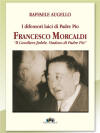 Francesco Morcaldi
Francesco Morcaldi
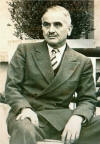
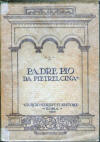 Emanuele Brunatto
Emanuele Brunatto
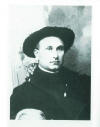 Don Giuseppe Orlando
Don Giuseppe Orlando
Morcaldi, Brunatto and Orlando went to Rome to prevent the transfer. Brunatto
told Gemelli that he was an eye witness that Gemelli had not examined Padre Pio.[14]
Gemelli replied: “I’ll have you destroyed!” Morcaldi told Cardinal Donato
Sbarretti that if they tried to remove Padre Pio, they “will have to trample on
our dead bodies.” Don Giuseppe Orlando met Don Alessandro Lottini at the Holy
Office. He returned whit a statement to Padre Pio: “They are accusing you of all
sorts of things, including that you are disobedient to the orders of your
superiors who have imposed upon you the obedience to leave this place.” Padre
Pio fell on one knee, opened his arms, and declared: “Peppino, I swear to you on
this crucifix that I never received such an order. If my superiors ordered me to
jump out of the window, I would jump.”
[15]
In the meantime, the townspeople were maintaining a round-the-clock guard at the
friary. Dr. Carmelo Camilleri was sent from Rome to explore the possibility of
moving Padre Pio. He concluded that Padre Pio could be taken away only by force
“with the certainty of an effusion of blood.” This became evident few days
later.[16]
[17]
On July 30, 1923 Padre Luigi D’Avellino, by order of the superior general
Giuseppe Antonio da Persiceto went to Padre Pio notifying him the he would be
transferred to another convent.”[18]
Padre Pio said: “I am ready to do the will
of my superiors. If at all possible I’d like to go to Montefusco.”[19]
On August 10, 1923 during vespers Padre Pio was about to bless the faithful with
the monstrance when a man, identified as Donato Centra, a bricklayer, lunged
forward and brandishing a revolver, leveled it at Padre Pio’s head. He shouted:
“Either dead or alive, you are going to stay with us in this town.” The
bystanders wrestled him to the ground before he could squeeze the trigger.[20]
[21]
[22]
On August 4, 1923 Padre Cherubino da Castelnuovo of the Ancona convent, notified
padre Pietro da Monteroberto, superior of the convent in Cingoli, that Padre Pio
would be transferred to that convent. Hearing that the removal of Padre Pio had
to be done in secret, Padre Cherubino suggested to hide Padre Pio in a large
barrel placed on a wagon. Padre Ignazio da Ielsi reported the episode and
commented that they didn’t know the people of San Giovanni Rotondo.[23]
On August 17, 1923 a telegram arrived from the Holy Office stating that the
transfer order was suspended until further notice.[24]
On October 2, 1923 Mary Pyle met Padre Pio.
On February 23, 1924 Padre Pietro da Ischitella dropped dead of a heart attack
at the age of forty four.[25]
On April 18, 1824 Padre Celestino da Desio was at the convent again, sent by the superior general. He
asked the superior Padre Ignazio if it was true that there had been a fistfight
among the friars to appropriate the offers sent to Padre Pio. Padre Ignazio was
appalled at this absurd accusation and said that he could imagine who was
spreading a similar calumny.[26]
In January 1925 the St. Francis hospital was opened.
On April 22, 1925 at the request of the Holy Office Padre Bernardo ordered:
visitors were no longer permitted to talk to Padre Pio in the sacristy,
corridor, or guest room. Padre Pio was prohibited to speak to any lay person
after Mass, and his hand had not to be kissed. No layman could reside in the
friary; Emanuele Brunatto went to Pietrelcina.
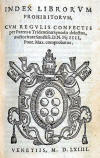 Index librorum prohibitorum "List of the forbidden
books"
Index librorum prohibitorum "List of the forbidden
books"
In 1926 Emanuele Brunatto wrote a book “Padre Pio da Pietralcina” exposing the
persecution of Padre Pio by Mons. Gagliardi. The book was promptly put on the
Index.[28]
In March 1927 a committee of Mons. Felice Bevilacqua, Emanuale Brunatto, and
Padre Alfredo Quattrino was sent by the Holy Office to investigate the cathedral’s chapter of
canons in the diocese of Manfredonia. Some of the canons were from the San
Giovanni Rotondo’s clergy, including don Giuseppe Prencipe, Miscio and
Palladino. The investigators dredged a wealth of sordid scandals.[29]
In May 1928 Mons. Bruno substituted Mons. Bevilacqua who had been dismissed.
Mons. Bruno focused on the archdioceses of Manfredonia and the Archbishop
Gagliardi. After the report was presented to the Holy Office Mons. Gagliardi
retired to his native village of Tricarico, Palladino was suspended “a divinis”
and went to the Tremiti islands, the archpriest Prencipe, the canon De Nittis
and canon Miscio had legal consequences.[30]
[31]
On January 3, 1929, Padre Pio’s mother died. He spent many hours at her bedside.[32]
On May 5, 1929 Padre Pio reported a dream that Mons. Gagliardi would leave and
Mons. Cuccarollo would be the new archbishop of Manfredonia.[33]
Mons. Gagliardi left. Mons Gagliardi was proposed but he refused for a more
lucrative assignment. Mons.
Alessandro Macchi was named Administrator of the archdioceses of Manfredonia in
June 1929.[34]
 The Holy Office on the right of an old postcard
The Holy Office on the right of an old postcard
On December 2, 1929, sent by the Holy Office, Mons. Macchi current went to
investigate Padre Pio. He reported: “Padre Pio might have been a saint, but now
he is a fool. He lacks the fundament of sanctity, which is humility. He used
cologne given to him by his bigot ladies.” He also presented a project to “take
Padre Pio to a convent in Switzerland.”[35]
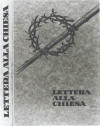 Lettera alla Chiesa (Letter to the Church)
Lettera alla Chiesa (Letter to the Church)
Emanuele Brunatto had written a book called “Letter to the Church.” The book
contained a defense of Padre Pio and uncovered the private lives of prominent
churchman opposed to him.[36]
Don Luigi Orione tried repeatedly to convince Brunatto not to publish the book.[37]
On March 31, 1931, the news spread in town that shortly a new superior would
come to the convent from the province of Milan, and that this move was the
harbinger of Padre Pio’s imminent transfer. Within short order the friary was
surrounded day and night by citizen armed to the teeth, just as it had been in
1923. Barricades were thrown up in the streets so that no vehicular traffic
could get to or from the friary.[38]
On April 7, 1931, unaware of the turmoil, Padre Eugenio Tignola, a Franciscan
friar, went to the convent by bus, hoping to talk to Padre Pio about a personal
problem. On the bus somebody wrongly suspected that he was coming to get Padre
Pio. Within minutes a news spread: “They are taking Padre Pio away!” At 10:00 PM
an ugly mob demanded that “the stranger” be handed over. Padre Raffaele refused.
The crowd smashed the wooden door with a light pole and entered the convent.
Padre Pio told the crowd from the window in the choir: “You have always been
good. Listen to me. Return to your homes without hurting anyone.” Major
Morcaldi, who was in the crowd, went to speak with Padre Raffaele, and was
convinced that “the stranger” was an armless guest. At about 2:30 AM on April 8
the crowd finally started to disperse. The report of what had happened soon
reached Rome, and action was taken soon.[39]
[40]
 Galileo Galilei questioned at the Holy Office
Galileo Galilei questioned at the Holy Office
On May 23, 1931 the Holy Office gave the following directive: “Padre Pio is
stripped of all the faculties of the priestly ministry except the faculty to
celebrate the Holy Mass, which he may do in private, within the walls of the
friary, in the inner chapel, and not publicly in church.” Padre Pio was notified
after vespers. He said: “The will of the authority is the will of God.”[41]
This period of Padre Pio’s life has been called “imprisonment”. He began his day
with the rest of the community saying the Office in the choir. He then prepared
for mass, and went to celebrate in the small chapel of the friary in the company
of one server. Since no time limit was set, the Mass lasted up to four hours. He
spent the rest of the day in study and prayer. One day Padre Agostino asked him
how he passed his time. Padre Pio: “I pray and study as much as I can, then
annoy my brothers. I joke the way I always joke with them, but my jokes are
worse than before.”[42]
Spiritually he was tormented by the thought of “weather I am pleasing the Lord
in what I am doing.” In 1931 he told Padre Agostino: “Jesus is silent.” In 1932
he told him “that often Jesus makes himself felt, speaking to his soul, and
granting him intellectual visions”. He also experienced the presence of Mary and
of his Guardian Angel.[43]
Padre Alberto testified: “From June 11, 1931 to July 15, 1933, Padre Pio could
say Mass only behind locked doors. I served his Mass many times during those two
years. It lasted about three hours. The memento was interminable. At the
Consecration he looked like Jesus Crucified. The memento of the dead was also
very long. At the Communion his face was bright and radiant. After Mass he went
to the choir for thanksgiving and meditation until noon.”[44]
Padre Pio frequently said: “The hand of the Church is sweet, even when it
strikes, because is the hand of the mother.”[45]
On May 23, 1931,
by specific disposition from Rome,
the superior general of the Capuchin Order ordered the closure of the Seraphic
College of the convent. Padre Pio was the spiritual director of the student, and
suffered intensely for the closure. The College, for middle school level
students, had been functioning since November 1909. The closure had to be
implemented “by extinction”, not accepting new students when the previous left.
By September 1932 all the students had left.[46]
On that date the seraphic college was transferred to the convent of Tora
(Caserta).[47]
In 1933 Emanuele Brunatto threatened to publish his book “Letter to the
Church”, if Padre Pio was not released.[48]
[49]
Padre Raffaele reported: “Padre Pio was sick in bed with a 118F fever, during
the Holy Week of 1933. The only thing he did was suffering and crying.”[50]
In 1933 Cardinal Eugenio Pacelli convinced Pope Pius XI to send a personal
representative to observe Padre Pio. On March 14, 1933 Mons. Luca Pasetto
a capuchin bishop of Gera
and Mons Felice Bevilacqua went to San Giovanni Rotondo, sent by the Pope.
Mons. Bevilacqua had been Apostolic Visitor in 1927.
They spent time with Padre Pio. They found no wild-eye fanatic, no crazed
neurotic, no embittered rebel, but a pleasant, humble, docile, humorous man; a
man of prayer and entirely godly. Bevilacqua warned Padre Pio about the terrible
damage to the Church should the revelations of Brunatto become public. Padre Pio
said: “The Church has a formidable weapon to neutralize the scandal, refuting
the episodes alleged in the book.” Mons. Bevilacqua, his eyes brimming with
tears, shook his head and said in a chocked voice: “Unfortunately, those
allegations are true.” The book was never published.[51]
Mons. Pasetto’s favorable report to the Pope was instrumental in modifying his
opinion about Padre Pio. In fact, soon the restriction where lifted.[52]
 The building of the Holy Office
The building of the Holy Office
On July 14, 1933 a “Indult” came from the Holy Office, signed by Cardinal
Sbarretti, directing that Padre Pio, in consideration that 1933 was a Holy Year
celebrating the Redemption, be allowed to celebrate Mass in public, and to hear
the confessions of the other friars.[53]
The evening of July 15 Padre Pio was notified the good news. The next day the
church was packed for Padre Pio’s first Mass in public in more than two years.[54]
There were still many restrictions remaining in place: he was not allowed to
hear the confessions of laypersons, the sacristy was off limits to all laity, he
could not speak to women or let them kiss his hand, the talks with men in the
hallway had to be few and brief, the Mass was not to last more than a half hour.
[55]
[56]
On March 25, 1934 Padre Pio was allowed by the Holy Office the confession of
men, and on May 12, 1934 he was permitted to hear the confessions and women.
[57]
Thus his ministry was once again in full
swing.[58]
August 10, 1935 was the 25th anniversary of priesthood of Padre Pio:
sober celebration among many faithful.[59]
August 29, 1936 the Provincial Padre Bernardo D’Alpicella reiterates that is
prohibited for lay people to enter in Padre Pio’s cell; also was ordered to keep
locked the cloths used by Padre Pio on the wounds, and whomever had they had to
return them. Otherwise if priests would be suspended a divinis, and if lay they
would be interdicted from receiving Holy Communion.[60]
In 1937 the accusations of not implementing the wows of poverty, chastity and
obedience intensified against Padre Pio, and many anonymous letters were sent to
the Holy Office. He was accused of managing by himself the conspicuous donations
of the faithful, of seeing women in the convent at night, of not obeying to say
Mass in 30 minutes. All the accusations were patiently evaluated, investigated,
and controlled by the superiors in the Capuchin order. Nothing was found to be
true.[61]
On August 7, 1938, the new superior general of Capuchins Father Donatus of
Welle, Belgium, visited Padre Pio. He wrote: “I examined the stigmata and
observed Padre Pio, and asked any
kind of questions. I can and must affirm that I consider Padre Pio a great
saint!”[62]
On March 2, 1939 Cardinal Eugenio Pacelli was elected Pope Pius XII. In one of
his first moves he ordered the Roman Congregations to “leave Padre Pio alone”
and called Padre Pio “The salvation of Italy.”[63]
[64]
January 1940. First meeting for the hospital “Casa Sollievo”.[65]
On September 4, 1940, Pope Pius XII exhorted the world to “pray, pray, pray”.
Padre Pio stated promptly: “Let’s roll our sleeves and respond to the call of
the Roman Pontiff.” The “Prayer Groups” were thus born.[66]
August 7-15, 1941 canonical visit of Padre Donato da Welle, superior general of
Capuchin order.
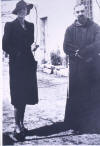
 On April 12, 1942 princess Maria Jose’ visited the convent and Padre Pio.[67]
On April 12, 1942 princess Maria Jose’ visited the convent and Padre Pio.[67]
 General Ezio Marta Gray visiting the convent.
General Ezio Marta Gray visiting the convent.
On January 6, 1945 Padre Pio celebrated a High Mass, sung by American soldiers,
as reported in the Chronicle of the convent.
[68]
On October 7, 1946 Padre Pio’s father dies, at the home of Mary Pyle, comforted
by his son.[69]
May 19, 1947: Lying of the first stone and steady work begins for the
construction of the Casa Sollievo della Sofferenza “Home for the Relief of
suffering”.
July 6, 1947 opens the Capuchin convent in Pietrelcina, financed by the American
heiress Mary Pyle.[70]
January 7, 1950 starts “reservation” for confession of women.
In 1951 the construction of the imposing Casa Sollievo was going strong. Money
was not a problem. The offerings were pouring in from all over the world. A new
war started for the management of the Casa, to snatch it from the hands of Padre
Pio.[71]
 The building of the Holy Office
The building of the Holy Office
On December 31, 1951. Mons. Giovanni Pepe, and the Benedictine abbot Emanuele
Caronti were sent by the Holy Office to investigate.”[72]
[73]
On January 16, 1952 the minister
general of the Capuchin order Padre Benigno da Sant’Ilario Milanese also sent
Padre Angelo da Genova for an investigation.”[74]
[75]
On July 6, 1952 Padre Benigno went personally to San Giovanni Rotondo, ordering
to discourage pilgrimages to the convent, and to not diffuse cards with the
image of Padre Pio.[76]
On July 30, 1952 the Holy Office
emanated a decree where eight publications about Padre Pio were put in the Index
of Forbidden Books, and on August 3, L’Osservatore Romano, explained that the
publications lacked the necessary ecclesiastical revision and approval.[77]
However, pope Pius XII had not been informed about it. When he was told about
it, the officer who had written the decree was fired, and the decree was not
implemented. At the same time the Holy Office received a letter signed by Mons.
Angelo Dell’Acqua, from the secretary of state of the pope, stating the Padre
Pio “had to be left undisturbed, to exercise his priestly ministry.”[78]
On January 22, 1953, Padre Pio celebrated the fiftieth anniversary of his
entrance in the Capuchin order. The community of friars assembled in the
refectory and from there led Padre Pio in procession to the church, singing
Psalm 121 “Laetatus sum���. At the altar, Padre Antonino da Sant’Elia a Pianisi,
provincial superior, delivered a short address, and received the renewal of the
votes from Padre Pio. Padre Pio then celebrated a solemn high Mass. In the
afternoon there was a thanksgiving service, were the famous tenor Beniamino
Gigli also sung.
Padre Pio wrote for his souvenir prayer card:
“Fifty years of religious life, fifty years nailed to the cross, fifty years of
devouring fire: for you, o Lord, for your redeemed. My soul nothing else desires
than bringing all of them to you and patiently wait that this devouring fire
burns all myself in the desire of dying.”[79]
During the pontificate of Pius XII Padre Pio had the needed freedom to implement
important social initiatives.[80]
May 5, 1954 grand opening of the Casa Sollievo della Sofferenza Home for the
relief of Suffering.
In December 1955 opened the coop “Cooperativa San Francesco”, strongly wanted by
Padre Pio to allow the town’s folks to buy food and other items at reasonable
price.[81]
On July 2, 1956 Padre Pio blessed the cornerstone of the new church of St. Mary
of Graces. The new church was consecrated by Bishop Paolo Carta, bishop of
Foggia, and the Capuchin Mons. Cirillo Giovanni Zohrabian, bishop of Acilisene,
on July 1, 1959.[82]
On December 17, 1957 was opened a new subdivision in Rione Santa Croce that
included a church, a preschool”, and a vocational center for girls wanting to
learn sewing and embroidering, managed by Franciscan sisters. In
the same time frame, in the subdivision another preschool was opened in
“Rione Sant’Onofrio that Padre Pio called “San Francesco d’Assisi”, managed by
the Capuchin sisters of the Sacred Heart. An orphanage was also opened in the
area.[83]
On January 26, 1958 was inaugurated The Vocational Center “San Giuseppe
Artigiano”, for youngsters wanting to learn a trade.[84]
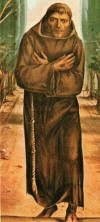
 St. Francis fresco by Antonio Ciccone.
St. Francis fresco by Antonio Ciccone.
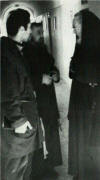
 Antonio conversing and praying with Padre Pio
Antonio conversing and praying with Padre Pio
In December 1958, Giuseppe Gentile, the architect of the new church of Santa
Maria delle Grazie commissioned a fresco depicting Saint Francis to Antonio
Ciccone. The location was a large space between the new church and the hallway
with the cells of the friars. Antonio started working in the spring of 1959m and
the fresco was completed on May 14, 1959. He lived in the convent during those
months, and had the possibility to be in contact with Padre Pio all day long.[86]
Antonio Ciccone was raised on the family farm on the Pataridde (Patariello)
area, behind the Capuchin convent in San Giovanni Rotondo.[87]
On July 1, 1959 took place the Consecration of the new church Santa Maria delle Grazie. The cornerstone had been placed on July 2, 1956.
Padre Pio:

 Pope John Paul II:
Pope John Paul II:

 Mother Theresa:
Mother Theresa:


Madonna of the graces:

 sacristy:
sacristy:



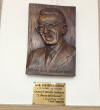 The architect was
Giuseppe Gentile, from Boiano. The mosaic behind the altar is by the mosaic
studio in Vatican City.
[88]
The architect was
Giuseppe Gentile, from Boiano. The mosaic behind the altar is by the mosaic
studio in Vatican City.
[88]
The original church of the convent was built in 1540, destroyed in the
earthquake of 1624, redone in 1629, and consecrated to St. Mary of the Graces on
July 5, 1676.[89]
In 1959 the Conference of Italian Bishops announced that the statue of Madonna
di Fatima would make a tour of Italian cities and towns. On April 25, 1959, as
the statue left the shrine of Fatima, Padre Pio fell ill. He became bedridden
and reached the point where he could no longer even drag himself out to say his
daily Mass. Each evening, by way of a microphone brought to his cell, he would
address a few words to the faithful. When the illness continued and worsened, a
team of doctors settled on a diagnosis of a tumor of the lungs and recommended
chemotherapy. Padre Pio actually laughed and told the doctors they were wrong.
Out of deference to Padre Pio, the Bishops Conference had arranged for the
“Pilgrim Virgin” to visit San Giovanni Rotondo. The statue arrived by helicopter
from Foggia on August 5. There was a whole day of prayer before the statue. On
August 6, the statue was taken into the sacristy were Padre Pio had been carried
down in a chair. Padre Pio stooped to kiss the statue and placed his rosary in
the Madonna’s hands. When the statue was about to leave by helicopter Padre Pio
has taken to a window to see the departure. When he saw the helicopter leaving
he broke down in tears and cried: “Mother, I have been sick during your visit to
Italy. Are you now leaving without curing me?” Then Padre Pio felt a chill
through his body. He exclaimed: “I am cured.” He was truly cured.[90]
[91]
.[85]
Agostino, d. S. (2012). Diario. San
Giovanni Rotondo: Edizioni Padre Pio.
Ago12
Alberto, D. P. (2007). Padre Pio of
Pietrelcina. Memories. Experiences. Testimonials. San Giovanni Rotondo:
Edizioni Padre Pio.
Alb07
Allegri, R. (1998). Padre Pio, un santo tra
noi. Milano: Edizioni Mondadori.
All98
Capuano, P. (2012). Con p. Pio: come in una
fiaba. Foggia: Grafiche Grilli.
Cap12
Castelli, F. (2011). Padre Pio under
investigation. The secret Vatican files. San Francisco: Ignatius Press.
Cas11
Chiron, Y. (1999). Padre Pio. Una strada di
misericordia. Milano: Figlie di San Paolo.
Chi99
Fortuna, A. (1999). Antonio Cicconès Padre
Pio. Florence: Latini.
For99
Gallagher, J. (1995). Padre Pio, The pierced
priest. London: HarperCollins.
Gal95
Giannuzzo, E. (2012). San Pio da Pietrelcina.
Il travagliato persorso della sua vita terrena. Book sprint edizioni.
Gia12
Napolitano, F. (1978). Padre Pio of
Pietrelcina. A brief biography. San Giovanni Rotondo: Edizioni Padre Pio.
Nap78
Peroni, L. (2002). Padre Pio da Pietrelcina.
Borla.
Per02
Pietrelcina, P. P. (2011). Epistolario I
Corrispondenza con i direttori spirituali (1910-1922). San Giovanni Rotondo:
Edizioni Padre Pio.
Epist. I
Ruffin, C. B. (1991). Padre Pio: the true
story. Huntington, Indiana: Our Sunday Visitor, Inc.
Ruf91
[1] Cas11, 292
[2] Cas11, 292
[3] Per02, 298
[4] Per02, 302
[5] Per02, 302
[6] Per02, 301
[7] Per02, 301
[8] Ruf91, 198
[9] Cas11, 292
[10] Per02, 303
[11] Ruf91, 193
[12] Per02, 307-8
[13] Ruf91, 189-98
[14] Per02, 339-1
[15] Per02, 319-20
[16] Ruf91, 189-98
[17] Per02, 310
[18] Per02, 311
[19] Per02, 312
[20] Per02, 313
[21] Ruf91, 197
[22] Cap12, 19
[23] Per02, 322
[24] Ruf91, 198
[25] Per02, 320-1
[26] Per12, 321
[27] Ruf91, 220-1
[28] Ruf91, 223
[29] Ruf91, 223-4
[30] Per02, 344
[31] Gia12, 277-8
[32] Per02, 352-5
[33] Ago12, 86
[34] Gia12, 282
[35] Ga12, 385
[36] Ruf91, 229
[37] Gia12, 285-6
[38] Ruf91, 229
[39] Ruf91, 110-30
[40] Per02, 365-7
[41] Per02, 368-9
[42] Ruf91, 231
[43] Ruf91, 232
[44] Alb07, 97-9
[45] Per12, 374
[46] Ago12, 101 note
[47] Cap12, 20
[48] Ruf91, 235
[49] Per12, 375-8
[50] Chi99, 220
[51] Ruf91, 234-5
[52] Ago12, 104-5 note
[53] Gia12, 301
[54] Per02, 378-9
[55] Per02, 399-400
[56] Gia12, 300
[57] Ago12, 106
[58] Ruf91, 236
[59] Cap12, 21
[60] Cap12, 21
[61] Gia12, 307-9
[62] Ruf91, 238
[63] Gia12, 311
[64] Alle98, 502
[65] Gia12, 315
[66] Gai12, 328-9
[67] Gia12, 312
[68] Cap12, 22
[69] Cap12, 22
[70] Gia12, 327-8
[71] Gia12, 3330-1
[72] Nap78, 158-61
[73] Gia12, 333
[74] Nap78, 161
[75] Gia12, 333
[76] Gia12, 332
[77] Nap78, 161
[78] Gia12, 333
[79] Epist. I, 1032
[80] Gia12, 332
[81] Gia12, 334
[82] Gia12, 326-7
[83] Gia12, 334
[84] Gia12, 334
[85] Gia12, 360-3
[86] For99, 31
[87] For99, 13-4
[88] Con01, 174-86
[89] Con01, 169
[90] Gal95, 168-9
[91] Nap78, 219-221
[92] Nap78, 221